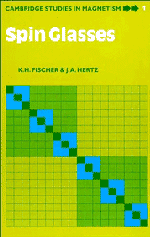Book contents
- Frontmatter
- Contents
- Preface
- 1 Introduction
- 2 Models, order parameters, and systems
- 3 Mean field theory I: Ising model, equilibrium theory
- 4 Introduction to dynamics
- 5 Mean field theory II: Ising dynamics
- 6 Mean field theory III: vector spins
- 7 Short-range interactions: low-temperature properties
- 8 Beyond mean field theory
- 9 Dynamics on many time scales
- 10 Specific heat, sound propagation, and transport properties
- 11 Competition between spin glass and ferromagnetic or antiferromagnetic order
- 12 One-dimensional models
- 13 Random field and random anisotropy
- 14 The physics of complexity
- 15 A short history of spin glasses
- References
- Index
12 - One-dimensional models
Published online by Cambridge University Press: 01 June 2011
- Frontmatter
- Contents
- Preface
- 1 Introduction
- 2 Models, order parameters, and systems
- 3 Mean field theory I: Ising model, equilibrium theory
- 4 Introduction to dynamics
- 5 Mean field theory II: Ising dynamics
- 6 Mean field theory III: vector spins
- 7 Short-range interactions: low-temperature properties
- 8 Beyond mean field theory
- 9 Dynamics on many time scales
- 10 Specific heat, sound propagation, and transport properties
- 11 Competition between spin glass and ferromagnetic or antiferromagnetic order
- 12 One-dimensional models
- 13 Random field and random anisotropy
- 14 The physics of complexity
- 15 A short history of spin glasses
- References
- Index
Summary
As in many problems, one-dimensional models can give some insight into the physics of spin glasses because they are easier to solve than those in higher dimensionality, but this advantage can be limited because the physics of the one-dimensional problem may be essentially different. Typically, for example, the higher-dimensional problem we really want to study has a broken symmetry phase at low temperature, while one-dimensional systems (with short-range interactions) do not exhibit broken symmetry at finite temperature.
Nevertheless, short-range one-dimensional systems can have broken symmetry at zero temperature, so one can study this relatively simple kind of order and the approach to it as the temperature is lowered to zero. This zero-temperature phase transition can be compared with finite-temperature transitions in higher dimensionality. This is the motivation for Section 12.1, where we will see that the critical point at T = h = 0 in a one-dimensional Ising spin glass with nearest-neighbour interactions has interesting features in common with finite-temperature spin glass transitions, and that they can be calculated analytically, sometimes rather simply.
Further insight can be gained by studying one-dimensional systems with long-range (typically power law) interactions. Then if the exponent describing the falloff of the interaction strength with distance is small enough, finite-temperature phase transitions are possible. Though such problems are harder to solve than nearest-neighbour ones, they can still be easier than the full higher-dimensional ones.
- Type
- Chapter
- Information
- Spin Glasses , pp. 327 - 336Publisher: Cambridge University PressPrint publication year: 1991



